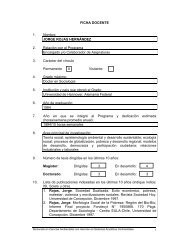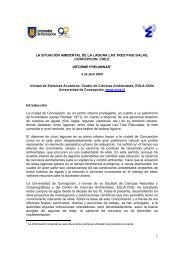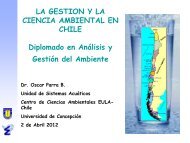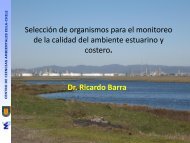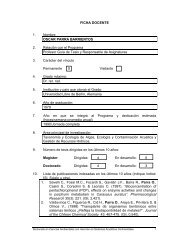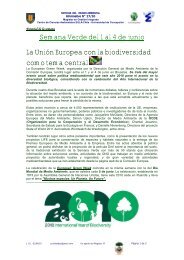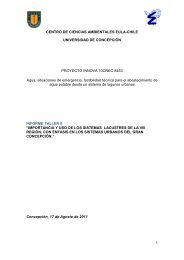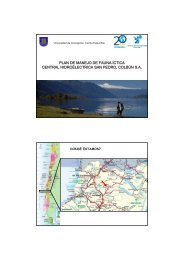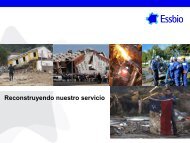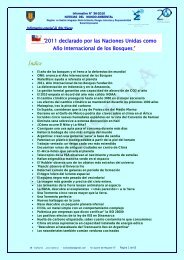Environmental Sciences Center EULA-CHILE: 20 years of existence
Environmental Sciences Center EULA-CHILE: 20 years of existence
Environmental Sciences Center EULA-CHILE: 20 years of existence
- No tags were found...
Create successful ePaper yourself
Turn your PDF publications into a flip-book with our unique Google optimized e-Paper software.
June <strong>20</strong>10. Year 1, No 2Contents3ontentsACCREDITATION OF THE 2PROGRAM• Doctoral program in environmentalsciences with specialization ininland water systems<strong>Environmental</strong> <strong>Sciences</strong> <strong>Center</strong> <strong>EULA</strong>-<strong>CHILE</strong>, Universidad de Concepción<strong>Environmental</strong> <strong>Sciences</strong> <strong>Center</strong><strong>EULA</strong>-<strong>CHILE</strong>: <strong>20</strong> <strong>years</strong> <strong>of</strong> <strong>existence</strong>“Providing environmental sustainability to the reconstruction”RESEARCH• Research for post-earthquake andtsunami reconstructionTRAINING4• Summary <strong>of</strong> the <strong>20</strong>09 results fromthe Training Programs in whichthe <strong>EULA</strong>-Chile <strong>Center</strong> is involved.OUTREACH ACTIVITIESNEWSRECENT PUBLICATIONS• ISI Publications• Non-ISI Publications• Book Chapters• Books561010101112Editor´s noteThe <strong>EULA</strong>’s observatory (OBEMA) for environmentalmonitoring, in the context <strong>of</strong> the reconstruction plan:A tool for transferring to the population scientificinformation associated with investment ordevelopment projects and with other environmentrelatedactions <strong>of</strong> the private and public sectorsthat incide in the people’s quality <strong>of</strong> life, natureprotection and the country’s development.Besides the challenge <strong>of</strong> applying interdisciplinarityin its theoretical and methodological approaches,the <strong>Environmental</strong> Science or <strong>Sciences</strong> face anotherchallenge, that <strong>of</strong> being an applied science andacting as one. The effects <strong>of</strong> human activities onecologic, economic, and social sistems produceconflicts which require solutions that are appropriateand timely to the context in which they aredeveloped. This is why the scientific knowledgegenerated by the environmental sciences must beproperly transferred to the community and to thepolitical and economic actors making the decisionsaimed at achieving the country’s sustainabledevelopment.The decision-making which is both economicallyand environmentally important has a better socialacceptance as it is based on the interdisciplinaryscientific and technical knowledge. An efficient wayto transfer this information to the community andat the same time to provide the necessary publicdebate are the so-called “<strong>Environmental</strong> MonitoringObservatories”. These are organisms or entitiesorganized independently or by an institution whosepurpose is to perform the environmental monitoring<strong>of</strong> investment or development projects <strong>of</strong>environmentally relevant actions (long-term andmajor plans or programs) and report objectively tothe community.During the <strong>20</strong> <strong>years</strong> <strong>of</strong> <strong>existence</strong> <strong>of</strong> the <strong>EULA</strong>-<strong>Center</strong>– founded four <strong>years</strong> before the promulgation <strong>of</strong>the General <strong>Environmental</strong> Framework Law Nº19.300/1994 – hundreds <strong>of</strong> projects have passedthrough the <strong>Environmental</strong> Impact Evaluation System(SEIA), some <strong>of</strong> which have been controversial at aregional and national level. Some <strong>of</strong> these projectshave even attracted the attention <strong>of</strong> the internationalcommunity (e.g.: projects in the area <strong>of</strong> energy,forest industry, mining, salmon farming, etc.).The OBEMA will institutionally and permanentlyassume the responsibility for doing theenvironmental monitoring <strong>of</strong> investment projectsthat are relevant in different production areas, <strong>of</strong>public and private environment-related initiativessuch as the promulgation <strong>of</strong> laws, standards,decontamination projects, productiondevelopments with influence on the use <strong>of</strong> naturalresources, urban expansions, civil infrastructureprojects, etc. To do so, the OBEMA will focus onthe work developed by a scientific community withexperience and active participation in environmentalissues, which is composed <strong>of</strong> researchers,academics, technicians, undergraduate andpostgraduate students <strong>of</strong> <strong>EULA</strong>, as well as academicsand students from other academic units at theUniversidad de Concepción.The OBEMA will be <strong>of</strong>ficially established this year.This corresponds to one <strong>of</strong> the <strong>EULA</strong>’s institutionalactivities with which the celebration <strong>of</strong> the <strong>20</strong> <strong>years</strong><strong>of</strong> life <strong>of</strong> the <strong>Center</strong> will begin. The Observatorywill be managed by an Executive Director appointedby the Director <strong>of</strong> <strong>EULA</strong> in consultation with theExecutive Committee <strong>of</strong> the <strong>Center</strong>. The <strong>EULA</strong>’s<strong>Environmental</strong> Monitoring Observatory will publishthe results <strong>of</strong> its activities and products through the<strong>EULA</strong> website, , and the <strong>EULA</strong> Newsletter.We establish the OBEMA this <strong>20</strong>10, a year whichwas marked by the earthquake and tsunami. TheOBEMA also begins its operations during thedevelopment <strong>of</strong> the country’s Reconstruction Plan,which will imply a series <strong>of</strong> projects that will requireenvironmental monitoring. This initiative willstrengthen the <strong>Center</strong>’s academic work in the areas<strong>of</strong> environmental diffussion and outreach, thusincreasing the transfer <strong>of</strong> knowledge and theinteraction with different actors <strong>of</strong> the regional,national and international communities.Dr. Oscar ParraDirector <strong>of</strong> <strong>EULA</strong>-Chile
ACCREDITATION OF THE PROGRAMACCREDITATION OF THE PROGRAMThe doctoral program in environmental sciences with specialization in inland watersystems receives accreditation for seven <strong>years</strong><strong>Environmental</strong> <strong>Sciences</strong> <strong>Center</strong> <strong>EULA</strong>-Chile, Universidad de Concepción.1989 - <strong>20</strong>10 Period.The Program was created in 1989 as aninitiative within the framework <strong>of</strong> the <strong>EULA</strong>-Chile Project from which the European-LatinAmerican International University <strong>Center</strong> for<strong>Environmental</strong> Research and Training -currently known as <strong>EULA</strong>-Chile <strong>Center</strong>- wascreated in close relationship with the Italiangovernment and academics from differentItalian universities.Nowadays, the Program has a stable staff <strong>of</strong>28 academics who teach and direct thesesand research. This interdisciplinary group hasdiverse pr<strong>of</strong>essionals such as biologists, marinebiologists, biochemists, chemists,geographers, civil, chemical, industrial, forestengineers, sociologists, among others. Most<strong>of</strong> them belong to the <strong>EULA</strong>-<strong>Center</strong>, but thereare also academics from the Faculties <strong>of</strong>Biological <strong>Sciences</strong>, Engineering, Sociology,Natural <strong>Sciences</strong> and Oceanography,Agricultural Engineering, and Chemical<strong>Sciences</strong>. Aditionally, the Program has strongrelationships with national and internationalorganisms whose cooperation is expressedthrough specialization courses during theacademic year or in the framework <strong>of</strong> the<strong>Environmental</strong> Summer School, held everysummer. To date, the Program also includesinternational co-tutors that help supervisedoctoral theses and international researchersthat participate in the final evaluationcommissions <strong>of</strong> graduates. This joint work ispossible thanks to the international researchprojects being carried out by the pr<strong>of</strong>essors<strong>of</strong> the Program.The first promotion <strong>of</strong> the Program graduatedin 1993. To date, 74 people have receivedthe Doctoral Degree, 12 <strong>of</strong> which are fromcountries such as Spain, Brazil, Peru, Panama,Mexico, Costa Rica, Uruguay and Venezuela.Throughout its history, the Program has beendirected by several academics: Dr. CarlosMillán (1989-1992), Dr. Lizandro Chuecas(1993), Dr. Víctor Ariel Gallardo (1994-1996),Dr. Lizandro Chuecas (1996-<strong>20</strong>00), Dr.Ricardo Barra (<strong>20</strong>00-<strong>20</strong>03) and Dr. GladysVidal (<strong>20</strong>04-to date). Almost from thebeginning <strong>of</strong> the Program, its Secretary hasbeen Ms. Lorena Valencia (1991-to date).The Program currently has 31 regular studentsat different stages <strong>of</strong> their training. Most <strong>of</strong>them are from Chile, but the Program alsohas the valuable presence <strong>of</strong> students fromPeru, Costa Rica, Colombia, and Ecuador. Allstudents have been granted scholarships forDoctoral studies. 84% <strong>of</strong> them havescholarships from the National Commission<strong>of</strong> Science and Technology (CONICYT) andthe rest are supported either by the Institute<strong>of</strong> Agricultural Research (INIA), theOrganization <strong>of</strong> American States (OAS), theResearch <strong>Center</strong> <strong>of</strong> Patagonian Ecosystems(CIEP), or the Graduate School <strong>of</strong> theUniversidad de Concepción.In May <strong>of</strong> this year, the Doctoral Program’sDirection received the news that the Programhad been accredited for seven <strong>years</strong>. This isone <strong>of</strong> two Doctoral Programs at the University(out <strong>of</strong> 23) that has been regarded as reliableby the National Accreditation Commission(CNA). This award represents a big challengefor a Program that must develop, mature,and become stronger in its goal <strong>of</strong> doing<strong>Environmental</strong> <strong>Sciences</strong>-related research,having at the same time a deep commitmentto regional and national issues and withoutneglecting the level <strong>of</strong> quality, presence andinternational connection.<strong>Environmental</strong> <strong>Sciences</strong> <strong>Center</strong> <strong>EULA</strong>-<strong>CHILE</strong>, Universidad de Concepción 2
RESEARCHRESEARCHResearch for post-earthquake and tsunami reconstruction.After last February’s earthquake, the Universityestablished the “UDEC RegionalReconstruction Program”, from which tenworking groups were constituted in differentsubject areas in order to effectively contributeto the reconstruction process in the BiobíoRegion. These groups will put their academicand infrastructure skills at the community’sservice through the joint work with localauthorities. In this context, the <strong>EULA</strong>-Chile<strong>Center</strong> coordinates Group 8 called“<strong>Environmental</strong> Impact and Recovery”, headedby Dr. Oscar Parra.From this perspective, the <strong>EULA</strong>-Chile <strong>Center</strong>and its researchers have developed 14different lines <strong>of</strong> action that originated theprojects listed below.• Project 1: Geo-referenced database <strong>of</strong> thelocation and characterization <strong>of</strong> the mainenvironmental issues emerging as aconsequence <strong>of</strong> the earthquake andtsunami in the Biobío Region. Mainresearcher: Dr. Mauricio Aguayo, Land andUrban Planning Research Unit, <strong>EULA</strong>-Chile<strong>Center</strong>, Universidad de Concepción.• Project 2: Effects <strong>of</strong> the earthquake on themorphology <strong>of</strong> rivers and its consequenceson (1) the behavior <strong>of</strong> floods, (2) theconstruction <strong>of</strong> civil works (bridges, realestateprojects, etc.), and (3) availability <strong>of</strong>habitats for the protection <strong>of</strong> the aquaticbiota. Main researcher: Dr. DiegoCaamaño, <strong>Environmental</strong> EngineeringResearch Unit, <strong>EULA</strong>-Chile <strong>Center</strong>,Universidad de Concepción.• Project 3: Quality <strong>of</strong> water <strong>of</strong> the mainrivers, lakes, lagoons, sources <strong>of</strong> drinkingwater, estuaries and the coastal marinearea. Main researcher: Dr. Ricardo Figueroa,Aquatic Systems Research Unit, <strong>EULA</strong>-Chile<strong>Center</strong>, Universidad de Concepción.• Project 4: Strategic management <strong>of</strong> urbansolid wastes. Main researcher: Dr. AlbertoBezama, <strong>Environmental</strong> EngineeringResearch Unit, <strong>EULA</strong>-Chile <strong>Center</strong>,Universidad de Concepción.• Project 5: <strong>Environmental</strong> Impact andRecovery <strong>of</strong> the Gran Concepción: quality<strong>of</strong> air. Main researcher: Dr. Jorge Jiménez,<strong>Environmental</strong> Engineering Research Unit,<strong>EULA</strong>-Chile <strong>Center</strong>, Universidad deConcepción.• Project 6: Early environmental assessment<strong>of</strong> the Reconstruction Plan projects in theBiobío Region. This project aims toincorporate the environmental variable incivil works considered in the ReconstructionPlan <strong>of</strong> the Biobío Region. Main researcher:M.Sc. Adolfo Acuña, Aquatic SystemsResearch Unit, <strong>EULA</strong>-Chile <strong>Center</strong>,Universidad de Concepción.• Project 7: Updated Chart <strong>of</strong> Natural HazardAreas in the Gran Concepción. Mainresearcher: Dr. María Mardones,Department <strong>of</strong> Earth <strong>Sciences</strong>, Faculty <strong>of</strong>Chemical <strong>Sciences</strong>, Universidad deConcepción.• Project 8: Evaluation <strong>of</strong> changes causedby the mega-earthquake on the biodiversity<strong>of</strong> marine and coastal wetlands <strong>of</strong> the BiobíoRegion, and development <strong>of</strong> restorationplans. Main researcher: Dr. ClaudioValdovinos, Aquatic Systems Research Unit,<strong>EULA</strong>-Chile <strong>Center</strong>, Universidad deConcepción.• Project 9: Scientific research program forthe environmental restoration <strong>of</strong> urbanlakes in the city <strong>of</strong> Concepción. Mainresearcher: Dr. Roberto Urrutia, AquaticSystems Research Unit, <strong>EULA</strong>-Chile <strong>Center</strong>,Universidad de Concepción.• Project 10: Study <strong>of</strong> a pilot system fordrinking water supply from the lagoonsystem <strong>of</strong> the Gran Concepción inemergency situations due to naturaldisasters. Main researcher: Dr. Ana CarolinaBaeza, <strong>Environmental</strong> Engineering ResearchUnit, <strong>EULA</strong>-Chile <strong>Center</strong>, Universidad deConcepción.• Project11:<strong>Environmental</strong> impact andrecovery <strong>of</strong> the landscape and the naturaland cultural heritage <strong>of</strong> the Biobío Region.Main researcher: Dr. (c) María DoloresMuñoz, Land and Urban Planning ResearchUnit, <strong>EULA</strong>-Chile <strong>Center</strong>, Universidad deConcepción.• Project 12: <strong>Environmental</strong> and HealthEducation Program in post-earthquake andtsunami emergency settlements. Theobjective <strong>of</strong> this project is to developeducational material taking intoconsideration different subjects for healthpromotion and environmental care. Mainresearcher: Pr<strong>of</strong>. Ana Lorena Castillo,<strong>Environmental</strong> Engineering Research Unit,<strong>EULA</strong>-Chile <strong>Center</strong>, Universidad deConcepción.• Project 13: Review and implementation <strong>of</strong>environmental regulations in a state <strong>of</strong>catastrophe and in the context <strong>of</strong> aReconstruction Plan. Main researcher:Attorney Bolívar Ruiz, CONAMA’s RegionalDirector and Pr<strong>of</strong>essor in the <strong>EULA</strong>-Chile<strong>Center</strong>, Universidad de Concepción.• Project 14: Analysis and evaluation <strong>of</strong> thesituation <strong>of</strong> domestic and industrial liquidwaste after the earthquake. Phase I:Collection <strong>of</strong> basic information for planningand management proposals. Mainresearcher: Dr. Gladys Vidal, <strong>Environmental</strong>Engineering Research Unit, <strong>EULA</strong>-Chile<strong>Center</strong>, Universidad de Concepción.June <strong>20</strong>10 3
TRAININGTRAININGSummary <strong>of</strong> the <strong>20</strong>09 results from the Training Programsin which the <strong>EULA</strong>-Chile <strong>Center</strong> is involved.<strong>Environmental</strong> engineering Stays and AgreementsIn <strong>20</strong>09, 54 students entered this program, Stays by students from other programs thanksthe final enter score reached 590.60 points, to agreements that <strong>EULA</strong> maintains with otherthe highest since the program was opened, institutions: Elizabeth Monsalvez, a Biologyand the first 6 <strong>Environmental</strong> Engineers student at the Universidad de Concepción,graduated. After the first promotion did a research stay for 6 months (fromgraduated, the program’s curriculum was September 3 rd to February 28 th , <strong>20</strong>09) atexamined and the necessary changes were the Spanish National Research Council, Spain,made, which coincided with the creation <strong>of</strong> under the guidance <strong>of</strong> Dr. Joseph Bayonathe <strong>Environmental</strong> Engineering Program at and with the financial support <strong>of</strong> the Alfa IItheFaculty <strong>of</strong> Agricultural Enginnering in 0543-FI-FA-FCD Project, “TECSPAR-SustainableChillán Campus. In <strong>20</strong>10, the new studies Technologies for Wastewater Purification andprogram has begun to be applied to the 57 Treatment”. Daniela López, a Marine Biologistnew students <strong>of</strong> the <strong>EULA</strong>- <strong>Center</strong> and to at our university conducted a research staythose <strong>of</strong> the aforementioned Faculty. at the Laboratory <strong>of</strong> <strong>Environmental</strong> and HealthMobility <strong>of</strong> UndergraduateStudentsDuring the <strong>20</strong>09-<strong>20</strong>10 period, the mobility<strong>of</strong> undergraduate students from the<strong>Environmental</strong> Engineering Program hascontinued. Within the framework <strong>of</strong> theExchange and Academic Mobility Program(PIMA-PROMADE Program) <strong>of</strong> theOrganization <strong>of</strong> Ibero-American States (OEI)and the Junta de Andalucía (AndalusianAutonomous Government), the studentGerardo Ortiz attended the Universidad deOlavide, in Seville, Spain. Jaime Hernándezand José Miguel Hernández went to theUniversidad Nacional del Litoral, in Santa Fe,Argentina, and Guillermo Rodríguez from theUniversidad de Guadalajara (<strong>20</strong>09), Mexico,and Matilde Aleu (<strong>20</strong>10) from Seville, Spain,were received in the program. Within theframework <strong>of</strong> the Bilateral Agreement withthe Universidad de Murcia, Spain, studentsPaola Jara, Valeria Hemmelmann and CamiloDe Los Santos attended this university in <strong>20</strong>09,whereas Soledad Pérez, Paz Quezada andNatalia Sánchez did it in <strong>20</strong>10. In turn, theProgram received the students Inés López(<strong>20</strong>09) and María Jesús Férez (<strong>20</strong>10) fromthat university. Finally, thanks to the BilateralAgreement with the Universidad de Córdoba,Spain, the student Victoria López came toour University to attend the <strong>Environmental</strong>Engineering Program for two academicperiods.During this year, we have been invited toparticipate in another PIMA-Engineeringnetwork, in which in addition to the <strong>EULA</strong>-<strong>Center</strong>, the Faculty <strong>of</strong> Engineering has alsobeen incorporated. This network is composed<strong>of</strong> the Universidad de Huelva, Spain, theInstituto Tecnológico de Monterrey, Mexico,the Universidad de San Carlos, Guatemalaand the Universidad de Concepción, Chile.Cleaner Production ThesisThe National Council for Clean Productionand the <strong>Environmental</strong> <strong>Sciences</strong> <strong>Center</strong> <strong>EULA</strong>-Chile have developed for the third year theContest “Thesis on Cleaner Production in theBiobío Region”, aimed at undergraduate andpostgraduate students who are working ontheir theses during the year each contest isheld. The following thesis projects wereapproved in <strong>20</strong>09:Microbiology <strong>of</strong> the Universitat Politècnica deCatalunya, Spain, for 9 months (November<strong>20</strong>08-September <strong>20</strong>09). This stay was fundedby the the Alfa II-0543-FI-FA-FCD Project,“TECSPAR-Sustainable Technologies forWastewater Purification and Treatment”.Finally, Elisabet André, an <strong>Environmental</strong>Engineering student from the ErasmusProgram at the Department <strong>of</strong> ChemicalEngineering <strong>of</strong> the Universidad de Valladolid(Valladolid, Spain) conducted a research stayat <strong>EULA</strong> between September <strong>20</strong>09 and July<strong>20</strong>10 under the guidance <strong>of</strong> Pr<strong>of</strong>. Dr. GladysVidal.Student’s Name Program Faculty Thesis Title Sponsoring Pr<strong>of</strong>essorWalter Noack <strong>Environmental</strong> <strong>EULA</strong>-<strong>Center</strong> “Estimación y gestión de la huella Claudia UlloaFirst Place Engineering de carbono de una planta cervecera artesanalde la Octava Región” (Estimation andManagement<strong>of</strong> the Carbon Footprint in a CraftBrewery <strong>of</strong> the VIII Region).Cindy Figueroa Bioengineering Biological “Recuperación de nutrientes de efluente Gladys VidalSecond Place <strong>Sciences</strong> tratado anaeróbicamente mediante obtenciónde estruvita”(Nutrient Recovery from anAnaerobically TreatedEffluent via StruviteProduction).Jacqueline <strong>Environmental</strong> <strong>EULA</strong>-<strong>Center</strong> “Diagnóstico de las cargas ambientales Alberto BezamaMéndez Engineering asociadasa la generación de energía eléctricaThird Placedel sistema interconectado central”.(Diagnosis <strong>of</strong> the <strong>Environmental</strong> LoadsAssociated with Electricity Generation in theChilean Central InterconnectedSystem).Fernanda Vidal <strong>Environmental</strong> <strong>EULA</strong>-<strong>Center</strong> “Establecimiento de una estrategia de gestión Alberto BezamaHonorable Engineering de RSD para la Región del Bío Bío, basadaMentionen el uso debiometano como sustituto degas natural” (Establishment <strong>of</strong> a DomesticSolid Waste Management Strategy for theBio Bío Region,Based on the Use <strong>of</strong>Biomethane as a Substitute for Natural Gas).Rodrigo Badillo Bioengineering Biological “Eliminación de nitrógeno presente en purines Gladys VidalHonorable <strong>Sciences</strong> de cerdo mediante procesos biológicos”Mention(Elimination <strong>of</strong> Nitrogen Present in PigManure by Biological Processes).Guillermo Bustos Civil Chemical Engineering “Producción de CaCl2 (seco) a partir de Fernando MárquezHonorable Engineering cloruro de hidrógeno y caliza” (Production <strong>of</strong>Mention(dry) Hydrogen Chloride and Limestone).<strong>Environmental</strong> <strong>Sciences</strong> <strong>Center</strong> <strong>EULA</strong>-<strong>CHILE</strong>, Universidad de Concepción 4
TRAININGOUTREACH ACTIVITIES<strong>Environmental</strong> ModuleThe environmental module <strong>of</strong>fered to all theUniversity programs has been maintained.This module is composed <strong>of</strong> 3 sequencialcourses: Introduction to the Study <strong>of</strong> theEnvironment, <strong>Environmental</strong> Issues <strong>of</strong> ModernSociety, and <strong>Environmental</strong> Management. In<strong>20</strong>09, 119 students from 34 programsattended this module and during the firstsemester <strong>of</strong> <strong>20</strong>10, two <strong>of</strong> the three courses<strong>of</strong> the module are being given to students.Postgraduate ProgramsCertificate Course in <strong>Environmental</strong>Analysis and Management13 pr<strong>of</strong>essionals from different fields graduatedfrom this Course in <strong>20</strong>09 and 17 studentsfrom the Certificate Course in <strong>Environmental</strong>Engineering attended modules I and II <strong>of</strong> thecourse. In <strong>20</strong>10, 11 students attend thisCertificate Course in <strong>Environmental</strong> Analysisand Management and 13 attend theCertificate Course in <strong>Environmental</strong>Engineering.Master’s Program in IntegratedManagement, Environment,Occupational Hazards, and CorporateSocial ResponsibilityThis program, which belongs to the Faculties<strong>of</strong> Engineering, Biological <strong>Sciences</strong> and the<strong>EULA</strong>-<strong>Center</strong>, is currently in its third version.It has 17 students from different academicfields, which along with those students fromthe previous class sum up a total <strong>of</strong> 25 studentswho make up the <strong>20</strong>09 version <strong>of</strong> theProgram. In April <strong>20</strong>10, the first 15 Master’sstudents in Integrated Managementgraduated. In <strong>20</strong>10, only 15 applicants forthe Program will be accepted.Doctoral Program in <strong>Environmental</strong><strong>Sciences</strong> with specialization in InlandWater Systems.Currently, this program has 31 students, 22<strong>of</strong> whom are supported by CONICYTscholarships. 6 Doctors graduated in <strong>20</strong>09.In <strong>20</strong>10, 6 students have been admitted tothe program in the first call for application, 1in the second call, and 5 <strong>of</strong> them have <strong>of</strong>ficiallyenrolled the Program; 3 <strong>of</strong> them haveCONICYT scholarships and 1 has a scholarshipfrom the Organization <strong>of</strong> American States.Seminar and ExhibitionThe Seminar “Lagoons for Concepción:Let’s recover the lagoons for the inhabitants<strong>of</strong> Concepción” was held in September<strong>20</strong>09 with a large attendance <strong>of</strong> citizensfrom Concepción. This seminar wasorganized by the <strong>EULA</strong>-<strong>Center</strong> and theMunicipality <strong>of</strong> Concepción. On thisoccasion, the travelling exhibition“Interurban Lagoons <strong>of</strong> Concepción” wasalso presented. This exhibition wasdeveloped by researchers <strong>of</strong> the <strong>Center</strong>and given as a present to the Municipalityso that it could be shown in the differentneighborhoods <strong>of</strong> the city.Regional ContestThe Regional Contest “Basins for theTercentenary”, a joint initiative between the<strong>EULA</strong>-<strong>Center</strong>, the EXPLORA Biobío Programand CONAMA Biobío, attracted manyparticipants. The prize-giving ceremony washeld in December <strong>20</strong>09 and the winnersin the short-story category were Luis Ossesand Jorge Sepúlveda with the works“Concepción de los Puentes Largos”(Concepción: City <strong>of</strong> Long Bridges) and“Lonquén: Un Río de Emociones” (Lonquén:A River <strong>of</strong> Emotions), respectively. In thephotography category, the first prize waswon by Christopher Aravena and MarcosGómez with the works “Fuera de Sí” (Out<strong>of</strong> Itself) and “Jóvenes Río Ñuble” (The youngfrom Ñuble River), respectively. The prizesconsisted <strong>of</strong> an aerial tour with a view <strong>of</strong>the Biobío Basin. Dr. Ricardo Figueroa,M.Sc. Silvia Basualto, Agric.Engineer PatricioParedes and Pr<strong>of</strong>. Ana Lorena Castilloparticipated in the ceremony.June <strong>20</strong>10 5
EXTENSIÓNOUTREACH ACTIVITIESNEWSSeminarOn April 13 th , <strong>20</strong>10, the Seminar“<strong>Environmental</strong> Impact and Recovery” washeld in the <strong>EULA</strong>-<strong>Center</strong>, in the framework<strong>of</strong> the UdeC Program for the RegionalReconstruction. In this opportunity,representatives from public, private and localacademic institutions participated<strong>EULA</strong> campaign for thevictims in LlicoIn March <strong>20</strong>10, the <strong>EULA</strong> community set upa solidarity campaign to provide support forthe victims <strong>of</strong> the earthquake and tsunami inthe towns <strong>of</strong> Llico and Arauco.<strong>Environmental</strong> <strong>Sciences</strong><strong>Center</strong> celebrates <strong>20</strong> <strong>years</strong><strong>of</strong> <strong>existence</strong>By the end <strong>of</strong> November <strong>of</strong> this year, the<strong>EULA</strong>-<strong>Center</strong> will celebrate <strong>20</strong> <strong>years</strong> <strong>of</strong><strong>existence</strong>. For this occasion, seminars,workshops and exhibitions on the topic"<strong>Environmental</strong> <strong>Sciences</strong>, consolidation andits contribution to the sustainable development<strong>of</strong> the country" will be carried out. On theoccasion, we expect the visit <strong>of</strong> Italiancolleagues who participated in the <strong>EULA</strong>Project, as well as former collaborators andChilean and foreign graduates from ourtraining programs. This activity was originallyscheduled for April, but the problems causedby the February 27 th earthquake and tsunamiforced us to postpone it to the aforementioneddate.A special ceremony for the first graduates <strong>of</strong>the Training Programs <strong>of</strong> the <strong>EULA</strong>-<strong>Center</strong> isplanned to be held, namely the DoctoralProgram in <strong>Environmental</strong> <strong>Sciences</strong> withspecialization in Inland Water Systems, theMaster’s Program in Integrated Management,Environment, Occupational Hazards andCorporate Social Responsibility (in conjunctionwith the Faculties <strong>of</strong> Engineering andBiological <strong>Sciences</strong>), the Certificate Course in<strong>Environmental</strong> Analysis and Managementand the undergraduate program in<strong>Environmental</strong> Engineering.New DIUC-Patagonia SeedProjectsManagement Agreementin Risk Prevention between<strong>EULA</strong>-<strong>Center</strong> and ACHSOn May 6 th , <strong>20</strong>10, the Agreement“Management in Risk Preventions, <strong>EULA</strong>-Chile<strong>Center</strong>, UDEC-ACHS” was signed betweenthe Chilean Safety Association (AsociaciónChilena de Seguridad, ACHS) and the <strong>EULA</strong>-Chile <strong>Center</strong>. Thanks to this agreement, theACHS will provide qualified consulting servicesin a joint implementation plan <strong>of</strong> GPS-ACHS.GPS-ACHS is an Occupational Health andSafety Management System that will enablethe <strong>EULA</strong>-<strong>Center</strong> to control risks in a practicaland effective way. It promotes and developsbehavior that is both safe and appropriatefor the worker’s self care. It will also preparethe <strong>Center</strong> to obtain the certification <strong>of</strong> itssafety and occupational health system,according to the international standard OHSAS18001:<strong>20</strong>07 (Occupational Health and SafetyManagement System). The GPS-ACHS Systemalso meets the requirements for the QualityManagement System ISO 9001:<strong>20</strong>00 andmay be easily integrated with anenvironmental management system basedon the ISO 14001:<strong>20</strong>04 standard.16 new Seed Patagonia projects wereapproved, four <strong>of</strong> which are from researchers<strong>of</strong> the <strong>EULA</strong>-<strong>Center</strong>, Drs. Alberto Araneda,Evelyn Habit, Ricardo Figueroa and GladysVidal. Each <strong>of</strong> these projects will receive about5 million Chilean pesos for a two year periodto conduct research in Patagonia that servesas a stepping-stone to apply for largercompetitive funds (Fondecyt, INNOVA,Fondef, etc).<strong>Environmental</strong> <strong>Sciences</strong> <strong>Center</strong> <strong>EULA</strong>-<strong>CHILE</strong>, Universidad de Concepción 6
NEWSNEWSDr. Oscar Parra is a member<strong>of</strong> the National ConsultativeCouncil <strong>of</strong> CONAMADr. Oscar Parra, Director <strong>of</strong> <strong>EULA</strong>, wasappointed a member <strong>of</strong> the NationalConsultative Council <strong>of</strong> CONAMA (Chile’sNational Commission for the Environment)for the period <strong>20</strong>10-<strong>20</strong>12, on behalf <strong>of</strong>scientists. According to the general provisions<strong>of</strong> the Law on the General Bases <strong>of</strong> theEnvironment, President Sebastián Piñeradesignated the members <strong>of</strong> this Council, whohold <strong>of</strong>fice for a period <strong>of</strong> two <strong>years</strong>, andwhich may be extended only once..Situation <strong>of</strong> the <strong>EULA</strong>-<strong>CHILE</strong> <strong>Center</strong> after the earthquakeThe <strong>EULA</strong>-Chile <strong>Center</strong> suffered some damagedue to the earthquake <strong>of</strong> last February.In terms <strong>of</strong> infrastructure, the damage wasas follows:• <strong>EULA</strong> building 1:Building with minor structural damage. Totalcollapse <strong>of</strong> false ceilings on the third floor,including lighting and ventilation systems <strong>of</strong>three classrooms and broken windows. Thestaircase showed non-structural damage; theeaves and stucco detached. Systems thatpump water to the third floor were destroyed.• <strong>EULA</strong> building 2:Building with no structural damage, onlysome broken windows and collapse <strong>of</strong> falseceilings. Two walls must be repaired.• <strong>EULA</strong> building 3 (Francesco Faranda):This was the building with the most damageon both the first and second floor. Aconsiderable structural damage is evidentthrough a crack in the slab between the firstand second floor, cracks in the walls <strong>of</strong> thebuilding, and the collapse <strong>of</strong> one part <strong>of</strong> thebuilding due to a probable sinking that mustbe evaluated for repair. There were brokenwindows in the entrance hall.Teaching and Research Equipment: The<strong>Environmental</strong> Chemistry Laboratory is wherethe biggest amount <strong>of</strong> equipment was eitherlost or severely damaged. The major damagereported is in the area <strong>of</strong> chromatography.In the laboratories <strong>of</strong> <strong>Environmental</strong> Biologyand Microbiology, there are estimated lossesespecially in optical equipment (photonmicroscopy), autoclaves, incubation ovensand precision balances. In the Laboratory <strong>of</strong>Geomatics and Computing, 22 computerswere damaged beyond recovery, as well asprinters and scanners. In the Laboratory <strong>of</strong><strong>Environmental</strong> Engineering andBiotechnology there was damage inequipment, loss <strong>of</strong> molecular reagents dueto the interruption <strong>of</strong> the cold chain and loss<strong>of</strong> expendable materials and strains used asbiosensors.The earthquake <strong>of</strong> February 27 th , <strong>20</strong>10 willsurely affect the growing activity rhythm <strong>of</strong>the <strong>Center</strong>, particularly with regard to researchand loss <strong>of</strong> equipment and research materials.It is for this reason that the recovery work indifferent areas is in progress and the physicalinfrastructure <strong>of</strong> the <strong>Center</strong> is expected to befully operational by the end <strong>of</strong> June <strong>of</strong> thisyear.Inauguration <strong>of</strong> academic activities for postgraduateprogramsOn April 22 th , <strong>20</strong>10, the opening ceremonyfor the academic year <strong>of</strong> the PostgraduatePrograms was held. On this occasion, Dr.María Mardones Flores, Pr<strong>of</strong>essor at theDepartment <strong>of</strong> Earth <strong>Sciences</strong> <strong>of</strong> the Faculty<strong>of</strong> Chemical <strong>Sciences</strong> gave a master classcalled “Natural Hazards and Disasters: AChallenge for Land-Use Planning”.June <strong>20</strong>10 7
NEWSNEWSThe following foreignstudents have doneresearch work at <strong>EULA</strong>• Michela Salvato from the Doctoral Programin Agricultural <strong>Sciences</strong> <strong>of</strong> the Universitàdegli Studi di Padova (Padua–Italy)conducted a research stay in theframework <strong>of</strong> the Alfa II-0543-FI-FA-FCDProject: “TECSPAR-Sustainable Technologiesfor Wastewater Purification and Treatment”(March 6 th –May 6 th , <strong>20</strong>09). ResponsiblePr<strong>of</strong>.: Gladys Vidal.• Cristina Alejandra Villamar Ayala (M.Eng.Scin <strong>Environmental</strong> Engineering) from theNational Polytechnic School (Quito-Ecuador). Ms.Villamar participates in theInnova Bio Bio Project 07-PC S1-198 asthe Project Engineer (April–January <strong>20</strong>09).Responsible Pr<strong>of</strong>.: Gladys Vidal.• Tatiana Costa, from Brazil, participates inthe Alfa GovAgua Project Nº II-0433-FA-FCD-FI and did her research work underthe guidance <strong>of</strong> Dr. Gerardo Azócar(March-August <strong>20</strong>09).• Golde Maria Sifelman, from Brazil,participates in the Alfa GovAgua ProjectNº II-0433-FA-FCD-FI and did her researchwork under the guidance <strong>of</strong> Pr<strong>of</strong>. M.Sc.Adolfo Acuña (March-August <strong>20</strong>09).• Elisabet Andrés García, from theUniversidad de Valladolid, Valladolid,Spain, is in the last year <strong>of</strong> the<strong>Environmental</strong> Engineering Program withthe support <strong>of</strong> the Erasmus MundusProgram. She is currently working on herundergraduate thesis, entitled: “Evaluaciónde la eliminación de nutrientes a travésde sistemas híbridos mediante lacombinación de grava y zeolita”(Evaluation <strong>of</strong> the nutrient eliminationthrough hybrid systems by thecombination <strong>of</strong> grave and zeolite) underthe guidance <strong>of</strong> Dr. Gladys Vidal(September <strong>20</strong>09-June <strong>20</strong>10).• Samia Nacimento Sulaiman, from theUniversidade de São Paulo, Brazil, is astudent <strong>of</strong> the Master’s Program in Culture,Organization and Education at thatUniversity. She participates in the GovAguaProgram and did her research under theguidance <strong>of</strong> Pr<strong>of</strong>. Ana Lorena Castillo (July-September <strong>20</strong>09).Estadía de estudiantes dedoctorado en el extranjeroDentro del Programa de Internacionalizacióndel Programa del Doctorado en CienciasAmbientales con mención en sistemasacuáticos han realizado estadías enreconocidos centros de investigacióninternacional los candidatos a doctores:• Catalina Plaza de Los Reyes. UniversitatPolitècnica de Catalunya, División eIngeniería Medioambiental delDepartamento Marina e IngenieríaAmbiental, España, bajo la supervisión delDr. Joan García (noviembre a diciembrede <strong>20</strong>09).• Mauricio Díaz. Universidade Federal do RíoGrande, bajo la supervisión de los pr<strong>of</strong>esoresJosé María Monserrat y Ana Rosi Linde Arias(27 de septiembre al <strong>20</strong> de diciembre,<strong>20</strong>09).• Gustavo Chiang Rojas. Universidad de Siena,Departamento de Ciencias Ambientales,bajo la supervisión de Dra. Cristina Fossi eIlaria Corsi (noviembre de <strong>20</strong>09 a enero de<strong>20</strong>10).• Alex García. Universidad de Idaho, EstadosUnidos, bajo la supervisión del Dr. PeterGoodwin (septiembre <strong>20</strong>08 a enero, <strong>20</strong>09)y INBO, Instituut voor Natur- enBosonderzoek, Bruselas, Bélgica, bajo lasupervisión del pr<strong>of</strong>esor Ans Mouton (01de agosto al 30 de septiembre, <strong>20</strong>09).• Fernanda Saavedra. Universidad deWaterloo, Canadá, bajo la supervisión delDr. Mark Servos (octubre a noviembre de<strong>20</strong>09).• Marisol Belmonte. Universidad de Santiagode Compostela, España, bajo la supervisiónde la Dra. Anuska Mosquera (diciembre<strong>20</strong>09 a abril de <strong>20</strong>10).• Denisse Alvarez. Universidad de Liege,Bélgica, bajo la supervisión de la Dra. NathalieFagel, Bélgica (21 de septiembre a 13 dediciembre, <strong>20</strong>09) y en la Universidad AdamaMickiewicza, Póznan, Polonia (14 al <strong>20</strong> dediciembre de <strong>20</strong>09).• Ismael Vera. Universitat Politécnica deCatalunya, España, bajo la supervisión delDr. Joan García (07 de Julio al 02 de octubre,<strong>20</strong>09).<strong>Environmental</strong> SummerSchool <strong>20</strong>10COURSES“Presence <strong>of</strong> organic micro-contaminantsin water: Characterization, effects andtreatment alternatives” (from January 04 thto 12 th , <strong>20</strong>10).Course Coordinator: Dr. Oscar Parra.Visiting Pr<strong>of</strong>essors:• Dr. Godwin Ayoko, Queensland University<strong>of</strong> Technology, Australia.• Dr. Silvano Focardi, Faculty <strong>of</strong> <strong>Sciences</strong>,Università di Siena, Italy.• Dr. Bernhard Karrasch, Helmholtz-Zentrumfür Umweltforschung (UFZ), Germany.• Dr. Detlef Knappe, North Carolina StateUniversity, USA.• Dr. Martin Pusch, Leibniz-Institut fürGewässerökologie und Binnenfischerei,Germany.“Revalorización de subproductos orgánicosdel sector agropecuario y las implicanciasambientales” (from January 11 th to <strong>20</strong> th ,<strong>20</strong>10).Course Coordinator: Dr. Gladys VidalVisiting Pr<strong>of</strong>essors:• Dr. Xavier Flotats i Ripoll, GIROTechnological <strong>Center</strong>, Barcelona, Spain.• Dr. Lorna Guerrero, Universidad TécnicoFederico Santa María, Valparaíso, Chile.• Dr. David Jeison, Universidad de laFrontera, Temuco, Chile.<strong>Environmental</strong> <strong>Sciences</strong> <strong>Center</strong> <strong>EULA</strong>-<strong>CHILE</strong>, Universidad de Concepción 8
NEWSNew DoctoralcandidatesThe students who entered the DoctoralProgram in <strong>20</strong>08, Catalina Plaza de LosReyes del Ríos, Pedro Pedreros Troncoso,and Catterina Sobones Vennekool, havesuccesfully passed all the stages <strong>of</strong> thequalifying examination and are nowcandidates to the Doctor’s Degree. Theyare currently working on the research fortheir Thesis Projects.Stays abroad <strong>of</strong> Pr<strong>of</strong>essorsfrom the <strong>EULA</strong>-<strong>Center</strong>• Stay <strong>of</strong> Pr<strong>of</strong>s. Dr. Claudia Ulloa and Dr.Jorge Jiménez at the Università degliStudi di Milano, Politecnico di Milano andUniversità degli Studi di Teramo, Italy.October 9 th -19 th .• Stay <strong>of</strong> Pr<strong>of</strong>. Dr. Alberto Araneda at IowaLakeside Laboratory, University <strong>of</strong> Iowa,USA. July 11 th -26 th .• Stay <strong>of</strong> Pr<strong>of</strong>. Dr. Jorge Jiménez atWashington State University. April 24 th-May 03 rd .• Stay <strong>of</strong> Pr<strong>of</strong>. Dr. Evelyn Habit at BrighamYoung University, USA, and DalhousieUniversity, Canada. November <strong>20</strong>09.• Stay <strong>of</strong> Pr<strong>of</strong>. Dr. Cristian Vargas at theFaculty <strong>of</strong> <strong>Sciences</strong> <strong>of</strong> the Universidad dela República, Uruguay, where he gavea lecture on plankton to postgraduatestudents from that university. December2 nd -12 th , <strong>20</strong>09.• Stay <strong>of</strong> Dr. Ricardo Barra at theDepartment <strong>of</strong> Chemistry <strong>of</strong> theUniversidad del Valle, Cali, Colombia.November 23 rd -27 th , <strong>20</strong>09.• Stay <strong>of</strong> Pr<strong>of</strong>. Marcelo Araya at theDepartment <strong>of</strong> City and Territory <strong>of</strong> theUniversità di Palermo, Italy. December10 th , <strong>20</strong>09-February 10 th , <strong>20</strong>10.Other Stays Abroad• Stay <strong>of</strong> María D. Carrasco at theDepartment <strong>of</strong> City and Territory <strong>of</strong> theUniversità di Palermo, Italy. December10 th , <strong>20</strong>09-February 10 th , <strong>20</strong>10.Workshops• “Aspectos emergentes asociados a lainvestigación y operación de fuentes deabastecimiento de agua potable de usomúltiple”. January 08 th , <strong>20</strong>10. Thisworkshop had over 60 attendees,including representatives from thecountry’s water companies and from thepublic and academic services in general.• “Hacia un desarrollo bioenergético delsector agropecuario: Oportunidades ydesafíos”. January 15 th , <strong>20</strong>10. Thisworkshop had over 60 attendees,including people from the public, privateand academic sectors.Recent graduates <strong>of</strong> theDoctoral Program in<strong>Environmental</strong> <strong>Sciences</strong>• Javiera Cárdenas Mancilla (Chile). DissertationTitle: “Efecto de los cambios de temperaturay nivel del mar sobre la malac<strong>of</strong>auna marinadurante el holoceno medio, región deMagallanes, Chile” (Effect <strong>of</strong> Changes inTemperature and Sea Level on the MarineMalac<strong>of</strong>auna During the Middle Holocene,Magallanes Region, Chile). Major Pr<strong>of</strong>essor:Dr. Claudio Valdovinos, <strong>Environmental</strong><strong>Sciences</strong> <strong>Center</strong> <strong>EULA</strong>-<strong>CHILE</strong>, Universidadde Concepción, January 08 th , <strong>20</strong>09.• Carlos Priego González de Canales (Spain).Dissertation Title: “Opinión pública,valoración y uso de espacios naturales enzonas urbanas: Análisis comparado entrelas ciudades de Halle (Alemania),Concepción (Chile) y Córdoba (España)”(Perception and Value <strong>of</strong> Nature in UrbanLandscapes: a Comparative Analysis <strong>of</strong> citiesin Germany, Chile and Spain). MajorPr<strong>of</strong>essor: Dr. Jorge Rojas, Faculty <strong>of</strong> Social<strong>Sciences</strong>, Universidad de Concepción,January 19 th , <strong>20</strong>09.• Mariela Valenzuela Huber (Chile).Dissertation Title: “Origen, dinámica espaciotemporaly factores ambientalesrelacionados a la contaminaciónmicrobiológica fecal de las aguassubterráneas de una microcuenca” (Origin,spatio-temporal Dynamics, andEnvironmetal Factors Related toGroundwater MicrobiologicalContamination at a Dryland RuralWatershed). Major Pr<strong>of</strong>essor: Dr. OscarParra, <strong>Environmental</strong> <strong>Sciences</strong> <strong>Center</strong> <strong>EULA</strong>-<strong>CHILE</strong>, Universidad de Concepción, January22 nd , <strong>20</strong>09.• Marcelo Lagos López (Chile). DissertationTitle: “Optimización metodológica para lazonificación de la amenaza de tsunamien un estuario como base para elordenamiento territorial de asentamientoscosteros (Maullín, X Región, Chile)”(Methodological Optimization for theTsunami Risk Zoning in an Estuary as aBasis for Land-Use Planning <strong>of</strong> CoastalSettlements). Major Pr<strong>of</strong>essor: Dr. MaríaMardones, Faculty <strong>of</strong> Chemical <strong>Sciences</strong>,Universidad de Concepción, April 15 th ,<strong>20</strong>09.• Silvia Lagos Padilla (Chile). Dissertation Title:“Calidad de vida laboral en el contextode responsabilidad social empresarial delsector forestal chileno” (Quality <strong>of</strong> WorkingLife in the Context <strong>of</strong> Corporate SocialResponsibility in the Chilean ForestryIndustry). Major Pr<strong>of</strong>essor: Dr. Jorge Rojas,Faculty <strong>of</strong> Social <strong>Sciences</strong>, Universidad deConcepción, April 12 th , <strong>20</strong>10.• Gabriela Mancilla Guajardo (Chile).Dissertation Title: “Efecto de la sustituciónde bosque nativo sobremacroinvertebrados en ríos de la cordillerade la costa chilena” (Effect <strong>of</strong> theSubstitution <strong>of</strong> Native Forest onMacroinvertebrates in Rivers <strong>of</strong> the ChileanCoast Range). Major Pr<strong>of</strong>essor: Dr. ClaudioValdovinos, <strong>Environmental</strong> <strong>Sciences</strong><strong>Center</strong> <strong>EULA</strong>-<strong>CHILE</strong>, Universidad deConcepción, April 23 rd , <strong>20</strong>10.June <strong>20</strong>10 9
PUBLICATIONSPUBLICATIONSISI Publications• Aedo, J.R. Belk, M.C. and Habit, E.M. (<strong>20</strong>09).Geographic Variation in Age, Growth and SizeStructure <strong>of</strong> Percilia irwini from South-CentralChile. Journal <strong>of</strong> Fish Biology 74, 278-284.• Aguayo, L. Barra, R. Becerra, J. and Martínez,M. (<strong>20</strong>09). Degradation <strong>of</strong> 2,4,6-tribromophenoland 2,4,6-trichlorophenol by AerobicHeterotrophic Bacteria Present in PsychrophilicLakes. World Journal <strong>of</strong> Microbiology &Biotechnology 25, 553-560.• Aguayo, M. Pauchard, A. Azócar, G. andParra, O. (<strong>20</strong>09). Cambio del uso del suelo enel centro sur de Chile a fines del siglo XX.Entendiendo la dinámica espacial y temporal delpaisaje. Revista Chilena de Historia Natural 82,361-374.• Araneda, A. Torrejón, F. Aguayo, M. Alvial, I.Mendoza, C. and Urrutia, R. (<strong>20</strong>09). Historicalrecords <strong>of</strong> Cipreses glacier (34°S): combiningdocumentary-inferred Little Ice Age evidencefrom Southern and Central Chile. Holocene 19(1),1173-1183.• Barra, R. Quiroz, R. Sáez, K. Araneda, A.Urrutia, R. and Popp, P. (<strong>20</strong>09). Sources <strong>of</strong>polycyclic aromatic hydrocarbons (PAHs) insediments <strong>of</strong> the Biobio River in south centralChile. <strong>Environmental</strong> Chemocal Letter 7, 133-139.• Caamaño, D. Goodwin, P. Buffington, J.M.Liou, J.C. and Daley-Larsen, S. (<strong>20</strong>09). Aunifying criterion for velocity reversal hypothesisin gravel-bed rivers. Journal <strong>of</strong> HydraulicEngineering ASCE, 135(1), 66-70.• Chamorro, S. Xavier, C. Hernández, V. Becerra,J. and Vidal, G. (<strong>20</strong>09). Aerobic removal <strong>of</strong>stigmasterol contained in kraft mill effluents.Electronic Journal <strong>of</strong> Biotechnology 12(2), 1-7.• Fernández, M. Astorga, A. Navarrete, S.Valdovinos, C. and Marquet, P. (<strong>20</strong>09).Deconstructing latitudinal species richness patternsin the ocean: does larval development hold theclue? Ecology Letters 12, 601-611.• Fiege, K. Miller, C.A. Robinson, L. Figueroa,R. and Peucker-Ehrenbrink, B. (<strong>20</strong>09).Strontium isotopes in Chilean rivers: the flux <strong>of</strong>unradiogenic continental Sr to seawater. ChemicalGeology 268, 337-343.• Habit, E. Jara, A. Colin, N. Oyanedel, A.Victoriano, P. González, J. and Solis, K. (<strong>20</strong>09).Threatened Fishes <strong>of</strong> the World: Diplomystescamposensis Arratia, 1987 (Diplomystidae).<strong>Environmental</strong> Biology <strong>of</strong> Fishes 84, 393-394.• Lang, N.J. Roe, K.J. Renaud, C.B. Gill, H.S.Potter, I.C. Freyh<strong>of</strong>, J. Naseka, A. Cochran, P.Pérez, H.E. Habit, E.M. Kuhajda, B.R. Lyons,J. Neely, D.A. Reshtnikov, Y. Salnikov, V.Stoumboudi, M.T. Mayden, R.L. (<strong>20</strong>09). Novelrelationships among lampreys(Petromyzontiformes) revealed by a taxonomicallycomprehensive dataset. Transactions <strong>of</strong> theAmerican Fisheries Society (72).• Mancilla, G. Valdovinos, C. Azócar, M.Henríquez, M. and Figueroa, R. (<strong>20</strong>09).Multimetric aproach to water quality evaluation<strong>of</strong> basin with different levels <strong>of</strong> antropicperturbation. Interciencia 34 (12), 587-864.• Moernaut, J. De Batist, M. Heirman, K. VanDaele, M. Pino, M. Brümmerb, R. and Urrutia,R. (<strong>20</strong>09). Fluidization <strong>of</strong> buried mass-wastingdeposits in lake sediments and its relevance forpaleoseismology: Results from a reflection seismicstudy <strong>of</strong> lakes Villarrica and Calafquén (South-Central Chile). Sedimentary Geology 213 (3-4),121-135.• Ortiz-S, J.J. Ortiz, N. Cifuentes, R. González,J. and Habit, E. (<strong>20</strong>09). Respuesta de lacomunidad de peces al dragado de ríos costerosde la Región del Biobío (Chile). Gayana 73(1),64-75.• Quiroz, R. Popp, P. and Barra, R. (<strong>20</strong>09).Analysis <strong>of</strong> PCB levels in snow from the AconcaguaMountain (Southern Andes) using the stir barsorptive extraction. <strong>Environmental</strong> Chemical Letter7, 283-288.• Rosenfeldt, E.J. Baeza, C. and Knappe, D.R.U.(<strong>20</strong>09). Effect <strong>of</strong> free chlorine application onmicrobial quality <strong>of</strong> drinking water inchloraminated distribution systems. JournalAmerican Water Works Association 101(10), 60-70.• Stehr, A. Debels, P. Arumí, J.L. Romero, F. andAlcayaga, H. (<strong>20</strong>09). Combining the Soil andWater Assessment Tool (SWAT) and MODISimagery to estimate monthly flows in a datascarceChilean Andean basin. Hydrological<strong>Sciences</strong> Journal 54(6), 1053-1067.• Ulloa, C.A. Gordon, A.L. García, X.A. (<strong>20</strong>09).Thermogravimetric study <strong>of</strong> interactions in thepyrolysis <strong>of</strong> blends <strong>of</strong> coal with radiata pinesawdust. Fuel Processing Technology 90, 583-590.• Unmack, P. Habit, E. and Johnson, J. (<strong>20</strong>09).New records <strong>of</strong> Hatcheria macraei from ChileanProvince. Gayana 73(1), 102-110.• Vargas, C.A. Martínez, R.A. Escribano, R. andLagos, N.A. (<strong>20</strong>09). Seasonal Relative Influence<strong>of</strong> Food Quantity, Quality, and Feeding Behaviouron Zooplankton Growth Regulation in CoastalFood Webs. Journal <strong>of</strong> the Marine BiologicalAssociation <strong>of</strong> United Kingdom 89, 1-13.• Vargas, C.A. and Martínez, R.A. (<strong>20</strong>09). Grazingimpact in natural populations <strong>of</strong> cilates anddin<strong>of</strong>lagellates over a river-influenced continentalshelf. Aquatic Microbial Ecology 56, 93-108.• Villamar, C.A. Jarpa, M. Decap, J. and Vidal,G. (<strong>20</strong>09). Aerobic moving bed bioreactortreating kraft mill effluents from Pinus radiata andEucalyptus globulus as raw material. WaterScience and Technology 59 (3), 507-514.• Von Gunten, L. Grosjean, M. Eggenberger,U. Grob, P. Urrutia, R. and Morales, A. (<strong>20</strong>09).Pollution and eutrophication history AD 1800 -<strong>20</strong>05 as recorded in sediments from five lakes inCentral Chile. Global and Planetary Change 63,198-<strong>20</strong>8.• Von Gunten, L. Grosjean, M. Rein, B. Urrutia,R. and Appleby, P. (<strong>20</strong>09). A quantitative highresolutionsummer temperature reconstructionbased on sedimentary pigments from LagunaAculeo, Central Chile, back to AD 850. TheHolocene 19, 873-881.• Von Gunten, L. Grosjean, M. Beer, J. Grob,P. Morales, A. and Urrutia, R. (<strong>20</strong>09). Agemodeling <strong>of</strong> young non-varved lake sediments:methods and limits. Examples from two lakes inCentral Chile. Journal <strong>of</strong> Paleolimnology 42,401-412.• Wright, S.J. Habit, E. Adlerstein, S. Parra, O.and Semrau, J.D. (<strong>20</strong>09). Graham ScholarsProgram: sustainability education through aninterdisciplinary international case study.Sustainability Science 4, 29-36.• Yeber, M.C. Soto, C. Riveros, R. Navarrete, J.and Vidal, G. (<strong>20</strong>09). Copper (II) and toxicityremoval using a photocatalytic process with TiO2as semiconductor. Chemical Engineering Journal152, 14-19.Non ISIPublications• Basualto, S. (<strong>20</strong>09). Gestión de los RecursosHídricos: Comparación de los aspectoslegales e institucionales entre Chile y Brasil.Aqua-LAC Journal <strong>of</strong> the UNESCO’sInternational Hydrological Programme forLatin America and Caribbean. Issue 2 (1),115-140.• Córdova, S. Gaete, H. Aránguiz, F. andFigueroa, R. (<strong>20</strong>09). Evaluación de lacalidad de las aguas del estero Limache(Chile central), mediante bioindicadores ybioensayos. Lat. Am. J. Aquat. Res., 37(2):199-<strong>20</strong>9. (SCIELO)• Franck, S. and Pérez, L. (<strong>20</strong>09). Más queuna suma de cosas: La unidad vecinal VillaSan Pedro de Coronel. Revista INVI, 24(67):127-152. ISSN: 0718-1299.• Monsálvez, E. Jarpa, M. Xavier, C. andVidal, G. (<strong>20</strong>09). Evaluación de tecnologíasde tratamiento biológicas convencionalespara eliminar potencial estrogénico deefluentes de celulosa. Tecnología del Agua,29 (307), 54-62.<strong>Environmental</strong> <strong>Sciences</strong> <strong>Center</strong> <strong>EULA</strong>-<strong>CHILE</strong>, Universidad de Concepción 10
PUBLICATIONSBook Chapters• Araneda, A. Martínez, C. & Urrutia R. (<strong>20</strong>09).Sedimentos del río Itata y área marina adyacente.In: Parra, O. Castilla, J.C. Romero, H. Quiñones,R. and Caamaño, A. (Eds.) “La cuenca hidrográficadel Río Itata: Aportes científicos para su desarrollosustentable”. Editorial Universidad de Concepción(Concepción, Chile), pp. 59-87, 389 p.• Azócar, G. and Aguayo, M. (<strong>20</strong>09). El desarrollosilvoagropecuario en la cuenca del río Itata:Situación actual y tendencias. In: Parra, O. Castilla,J.C. Romero, H. Quiñones, R. and Caamaño, A.(Eds.) “La cuenca hidrográfica del Río Itata: Aportescientíficos para su desarrollo sustentable”. EditorialUniversidad de Concepción (Concepción, Chile),pp. 241-255, 389 p.• Basualto, S. Parra, O. Acuña, A. Figueroa, R.and Azócar, G. (<strong>20</strong>09). Aspectos de la Gestióndel agua en Chile. In Jacobi, P.R. and Sinisgalli,P. (Eds.) “Gobernanza del agua y de las PolíticasPúblicas en Latinoamérica y Europa”. EditorialAnnablume (São Paulo, Brazil). Vol. I p. 85, 217p.• Basualto, S. (<strong>20</strong>09). Water crisis or governabilitycrisis?. In Jacobi, P.R. and Sinisgalli, P. (Eds.)“Political and Institutional Dimensions <strong>of</strong> WaterGovernance in Latin America and in Europe”.Editorial Annablume (São Paulo, Brazil). Vol II,pp. 197-211. 250 p.• Di Cesare, M. and Acuña, M. (<strong>20</strong>09).Características socio-demográficas de la poblaciónde la cuenca del Río Itata. In: Parra, O. Castilla,J.C. Romero, H. Quiñones, R. and Caamaño, A.(Eds.) “La cuenca hidrográfica del Río Itata: Aportescientíficos para su desarrollo sustentable”. EditorialUniversidad de Concepción (Concepción, Chile),pp. 257-267, 389 p.• Dussaillant, A. (<strong>20</strong>09). Hidrología de la cuencadel río Itata. In: Parra, O. Castilla, J.C. Romero,H. Quiñones, R. and Caamaño, A. (Eds.) “Lacuenca hidrográfica del Río Itata: Aportes científicospara su desarrollo sustentable”. EditorialUniversidad de Concepción (Concepción, Chile),pp. 27-43, 389 p.• Fuentes, P. and Pérez, L. (<strong>20</strong>09). Campusuniversitarios en Chile. Formas alternativas delurbanismo moderno. In: Torrent, H. & Ferrada,J. (Eds.) “Patrimonio moderno y ciudad”. EditorialUniversidad de Valparaíso-DOCOMOMO(Valparaíso, Chile). pp. 94-98. 134 p. ISBN 978-956-332-242-2.• Grünewald, V. Figueroa, R. and Parra, O.(<strong>20</strong>09). Water resources and mining activities inthe Aymara territory. In Jacobi, P.R. and Sinisgalli,P. (Eds.) “Water governance in Latin American:social players, conflicts and territoriality”. EditorialAnnablume (São Paulo, Brazil). Vol III, pp. 175-194. 213 p.• Habit, E. and Ortiz, N. (<strong>20</strong>09). Composición,distribución y conservación de los peces de aguadulce de la cuenca del río Itata. In: Parra, O.Castilla, J.C. Romero, H. Quiñones, R. andCaamaño A. (Eds.) “La cuenca hidrográfica delRío Itata: Aportes científicos para su desarrollosustentable”. Editorial Universidad de Concepción(Concepción, Chile), pp. 127-141, 389 p.• Link, O. Monsalve, A. Stehr, A. García, A. andUrrutia, R. (<strong>20</strong>09). Régimen térmico del río Itata.In: Parra, O. Castilla, J.C. Romero, H. Quiñones,R. and Caamaño, A. (Eds.) “La cuenca hidrográficadel Rio Itata: Aportes científicos para su desarrollosustentable”. Editorial Universidad de Concepción(Concepción, Chile), pp. 45-57, 389 p.• Muñoz, M.D. (<strong>20</strong>09). Paisaje y estructuraterritorial en la cuenca del río Itata. In: Parra, O.Castilla, J.C. Romero, H. Quiñones, R. andCaamaño, A. (Eds.) “La cuenca hidrográfica delRio Itata: Aportes científicos para su desarrollosustentable”. Editorial Universidad de Concepción(Concepción, Chile), pp. 269-289, 389 p.• Parra, O. Acuña, A. and Basualto, S. (<strong>20</strong>09).La cuenca hidrográfica como unidad de estudioy gestión del territorio regional. In: Parra, O.Castilla, J.C. Romero, H. Quiñones, R. andCaamaño A. (Eds.) “La cuenca hidrográfica delRío Itata: Aportes científicos para su desarrollosustentable”. Editorial Universidad de Concepción(Concepción, Chile). pp. 13-25. 389 p.• Parra, O. Castilla, J.C. Romero, H. Quiñones,R. and Caamaño, A. (<strong>20</strong>09). Reflexiones sobrela gestión ambiental integrada y perspectivasfuturas de desarrollo sustentable de la cuencadel Itata. In: Parra, O. Castilla, J.C. Romero, H.Quiñones, R. and Caamaño, A. (Eds.) “La cuencahidrográfica del Río Itata: Aportes científicos parasu desarrollo sustentable”. Editorial Universidadde Concepción (Concepción, Chile). pp. 347-352. 389 p.• Parra, O. Urrutia, R. Cruces, F. and Alvarez,D. (<strong>20</strong>09). Fitoplancton y fitobentos río Itata. In:Parra, O. Castilla, J.C. Romero, H. Quiñones, R.and Caamaño, A. (Eds.) “La cuenca hidrográficadel Río Itata: Aportes científicos para su desarrollosustentable”. Editorial Universidad de Concepción(Concepción, Chile). pp. 101-109. 389 p.• Parra, O. Muñoz, M.D. and Pérez, L. (<strong>20</strong>09).Gestión integrada de cuencas como base delordenamiento territorial descentralizado. In: VonBaer, H. (Ed.) “Pensando Chile desde susregiones”. Editorial Universidad de la Frontera:Serie AU-Sinergia Regional (Temuco, Chile),October <strong>20</strong>09. pp. 490-494. 819 p.• Pérez, L. and Salinas, E. (<strong>20</strong>09). Fragmentosde ciudad. Transformaciones del Concepciónmetropolitano. In: Hidalgo, R. De Mattos, C. andArenas, F. (Eds.) “Chile: Del país urbano al paísmetropolitano”. Editorial Pontificia UniversidadCatólica: GEOlibros Series and EURE Libros Series(Santiago, Chile). pp. 269-300. 469 p. ISBN: 978-956-14-1054-1.• Urrutia, R. Parra, O. Cruces, F. Araneda, A.Barra, R. and Cid, H. (<strong>20</strong>09). Calidad de Aguadel Río Itata. In: Parra, O. Castilla, J.C. Romero,H. Quiñones, R. and Caamaño, A. (Eds.) “Lacuenca hidrográfica del Río Itata: Aportescientíficos para su desarrollo sustentable”. EditorialUniversidad de Concepción (Concepción, Chile).pp. 89-109. 389 p.• Valdovinos, C. Mancilla, G. and Figueroa, R.(<strong>20</strong>09). Biodiversidad dulceacuícola de Chilecentral: Macroinvertebrados bentónicos del RíoItata. In: Parra, O. Castilla, J.C. Romero, H.Quiñones, R. and Caamaño, A. (Eds.) “La cuencahidrográfica del Río Itata: Aportes científicos parasu desarrollo sustentable”. Editorial Universidadde Concepción (Concepción, Chile). pp. 111-125. 389 p.• Vidal, G. Jarpa, M. Plaza de Los Reyes, C.Belmonte, M. and Mariangel, L. (<strong>20</strong>09).Sistemas de tratamientos convencionales vs.sistemas naturales. In: Peñuela, G. and Morató,J. (Eds.) “Manual de tecnologías sostenibles entratamiento de aguas”. Ediciones DivergráficasLtda. PBX: 5117616 (Medellín, Colombia), ISBN978-958-44-5307-5, pp. 31-42. 113 p.• Vidal, G. Hsieh, Ch-F. Rodríguez, C. andBelmonte, M. (<strong>20</strong>09). Deyecciones ganaderas:desafíos y oportunidades de un país en desarrollo.In: Peñuela, G. and J. Morató (Eds.) “Manual degestión sostenible del agua: Evaluación de lacalidad, tratamiento y reutilización”. EdicionesDivergráficas Ltda. PBX: 5117616 (Medellín,Colombia), ISBN 978-958-44-3709-9, pp. 67-72.113 p.• Zaror, C. Urrutia, R. Vidal, G. and González,P. (<strong>20</strong>09). Aspectos ambientales de las actividadeshumanas de la cuenca del río Itata. In: Parra, O.Castilla, J.C. Romero, H. Quiñones, R. andCaamaño, A. (Eds.) “La cuenca hidrográfica delRío Itata”. Editorial Universidad de Concepción(Concepción, Chile). pp. 311-317. 389 p..June <strong>20</strong>10 11
PUBLICATIONSPUBLICATIONSBooks• Parra, O. Castilla, J.C. Romero, H.Quiñones, R. and Caamaño, A. (Editores).(<strong>20</strong>09). “La Cuenca Hidrográfica del ríoItata: Aportes científicos para su desarrollosustentable”. Editorial Universidad deConcepción. 389 pp.• Urrutia, R. Parra, O. and Acuña, A.(<strong>20</strong>09). Water Resources Management inChile: A multidisciplinary approach. Proy.Alfa Govagua - Universidad de Concepción.The Eula-Newsletter is edited by the<strong>Environmental</strong> <strong>Sciences</strong> <strong>Center</strong> <strong>EULA</strong>-Chile <strong>of</strong>the Universidad de Concepción.Printed by Trama Impresores.• Editorial Staff:- Dr. Gladys Vidal, <strong>Environmental</strong> EngineeringResearch Unit, Director.- Dr. Cristian Vargas, Aquatic Systems ResearchUnit.- Dr. Mauricio Aguayo, Land and Urban PlanningResearch Unit.• www.eula.cl• Phone: 041 / 2<strong>20</strong>4073<strong>Environmental</strong> <strong>Sciences</strong> <strong>Center</strong> <strong>EULA</strong>-<strong>CHILE</strong>, Universidad de Concepción12



